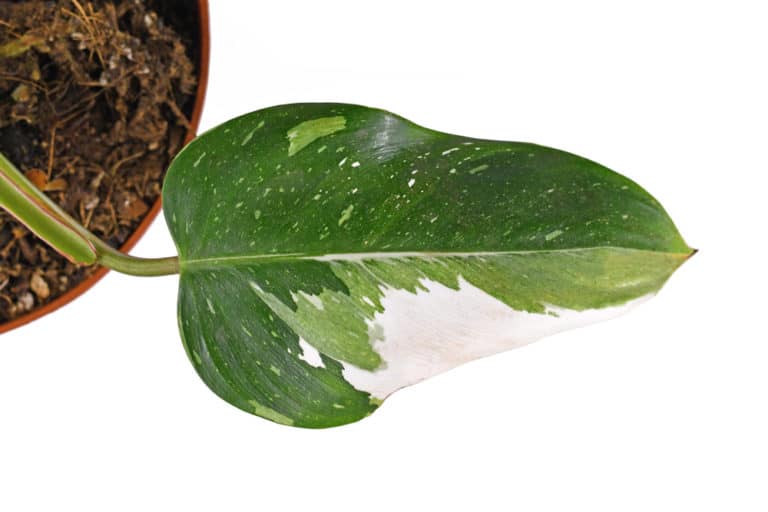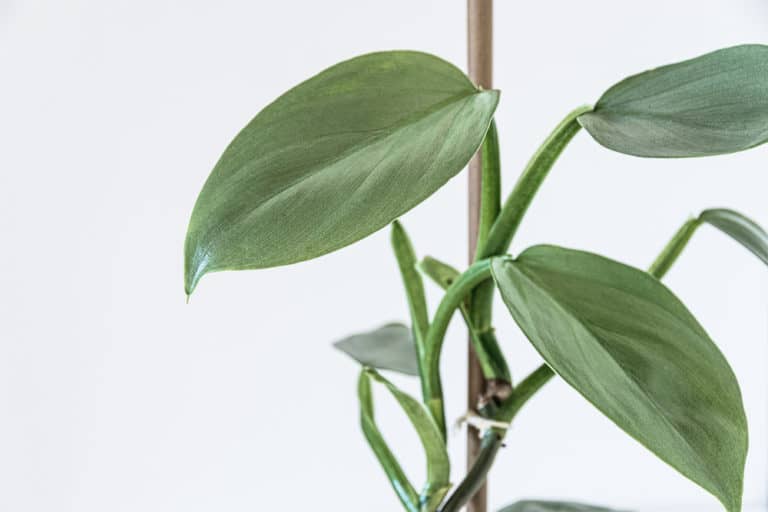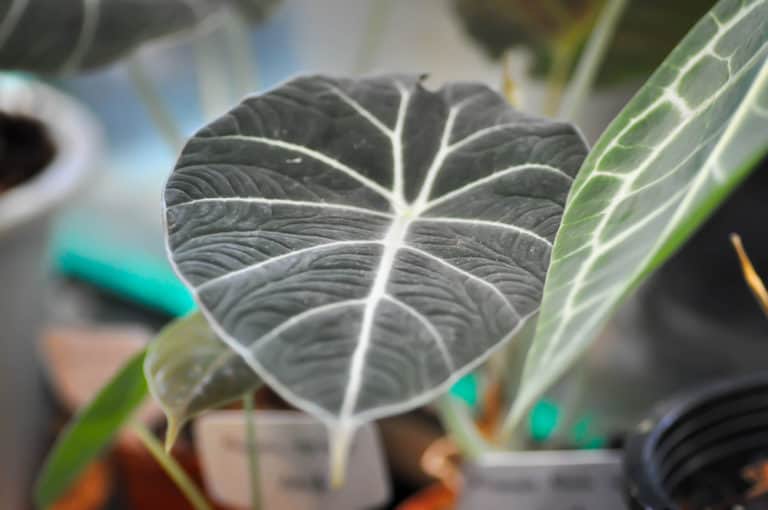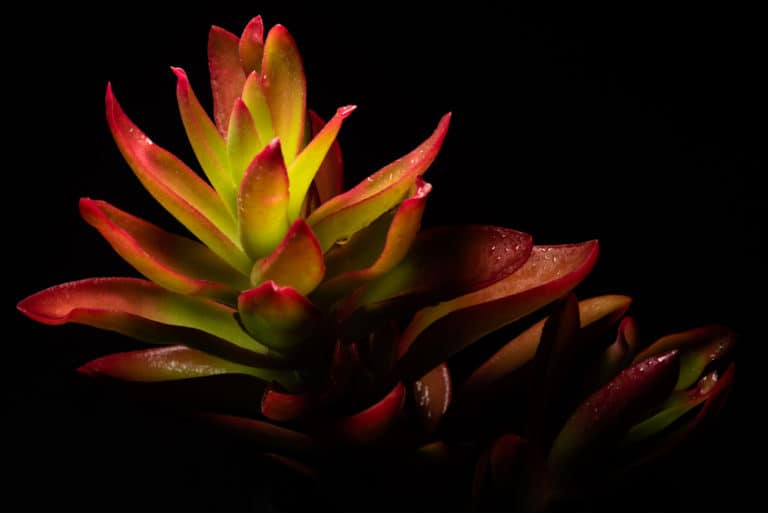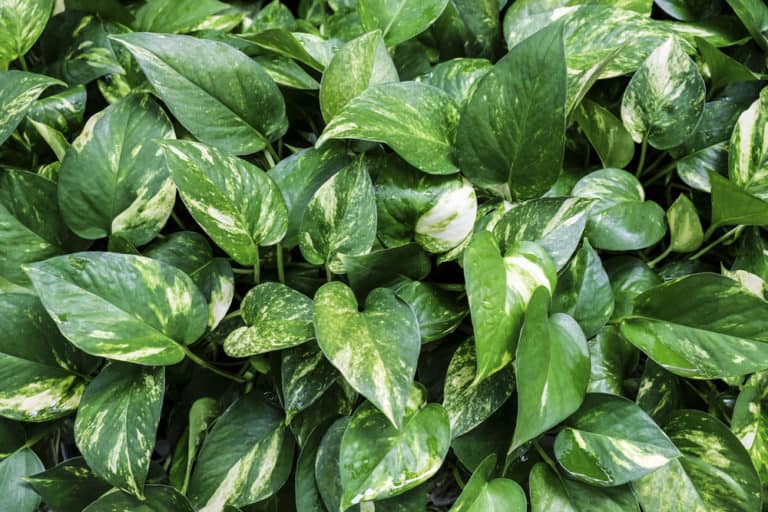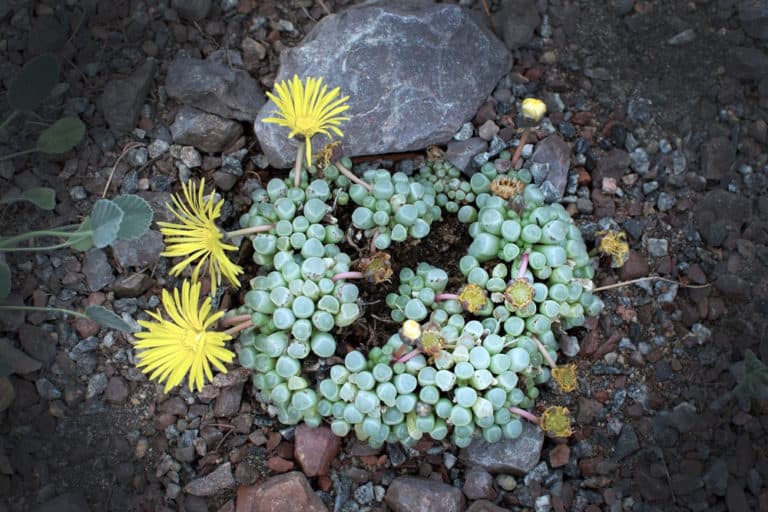Philodendron ‘Birkin’ Care Guide (2024)
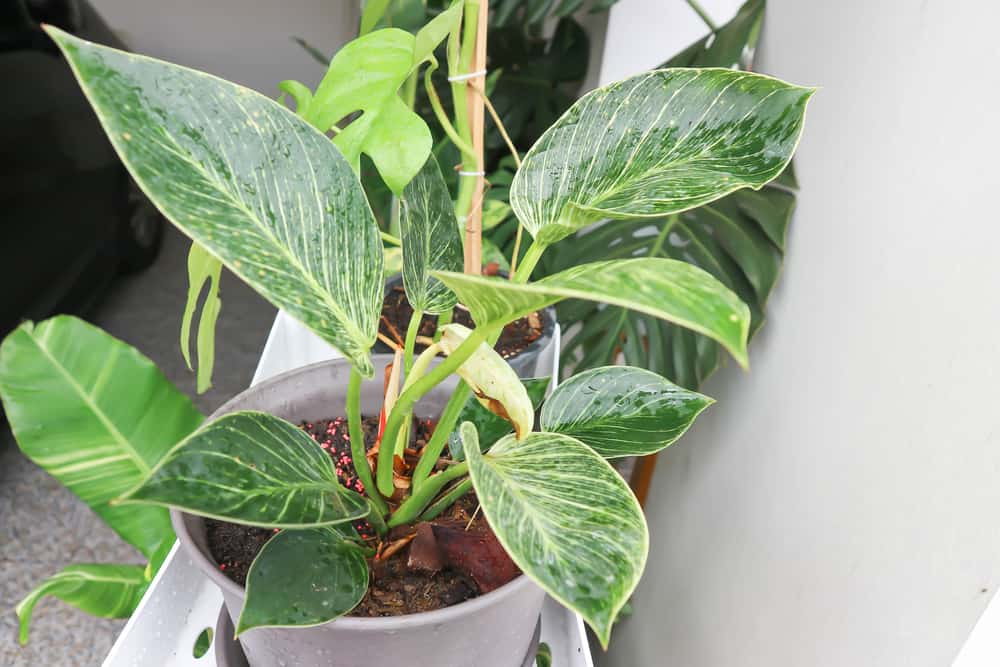
Philodendron birkin is a fascinating Philodendron cultivar with a mysterious past.
Noted for its striking pinstriped leaves, the Birkin plant has become an extremely fashionable houseplant in the last few years.
Not only is it an attractive addition to your indoor garden, but it does not require a lot of attention to maintain its good looks.
| Scientific Name | Philodendron ‘Birkin’ |
| Common Name | Philodendron birkin, White Wave |
| Light | Bright indirect sunlight |
| Watering | Weekly, water if the top 2 inches of soil are dry |
| Temperature | 65 to 85ºF (18 to 25ºC) |
| Hardiness Zone | 10-12 |
| Humidity | 40-70% |
| Soil Type | Rich, quick-draining, loamy |
| Soil pH | 6-7 (mildly acidic to neutral) |
| Fertilizing | A balanced feed once a month in spring and summer |
| Repotting | Every 2 years |
| Pruning | Spring or fall |
| Propagation | Root in water or soil |
| Toxicity | Toxic to humans and pets |
| Mature Size | 36 inches as a houseplant |
| Bloom Time | Rarely blooms indoors |
What’s Unique About Philodendron birkin?
Philodendrons are native to the tropical rainforests of Brazil, but a Philodendron birkin plant has never grown there.
This cultivar developed as a spontaneous mutation on a Philodendron Rojo Congo, and when it was propagated it was found to be stable.
Philodendron birkin plants feature a unique pattern of cream pinstripes against a green background on their leaves.
Growing Philodendron birkin is easy even for beginners, as it does not need much in the way of maintenance.
As an added bonus, philo birkin, like all philodendrons, is great for filtering airborne contaminants such as formaldehyde.
Thus it will not only beautify your home, but give you a healthier indoor environment.
Philodendron birkin Care
The Philodendron family of plants originates in Brazil’s tropical rainforests. Philodendron birkin is a modern cultivar and has never grown in that wild environment.
Still, Philodendron birkin plant care still entails providing your houseplant with a close approximation of those growing conditions.
For the best Birkin plant care, keep your Philodendron birkin in a warm, humid spot out of direct sun.
Light
In the Brazilian rainforest, philodendrons grow under the dense canopy of trees. While lots of light still gets through, they are protected from the blazing rays of the tropical sun.
Thus, Philodendron birkin light requirements are for bright but indirect light, or between 10,000 and 20,000 lux.
You can easily accommodate Birkin plant light needs in almost any room.
An ideal spot is right in the window of a north or east room, where the morning sun is less intense.
If you only have a south or west exposure, find a spot out of the full sun.
In an office with no windows, 12 hours per day of good artificial light will also be sufficient. Grow lights also work well for Philodendron birkin.
Watering
Philodendrons are used to consistently moist but never wet soil in the tropical rainforest.
For your Philodendron birkin watering, you should aim for soil that’s like a damp sponge rather than one that’s dripping wet.
Water Birkin plant when the top inch or 2 of soil is dry, but do not let the soil dry out completely.
Philodendron birkin’s watering needs are best met by soaking the entire pot in a pail or sink until the soil is fully moistened. Let all excess water drain out before placing the pot back on its saucer.
Distilled or rain water is best for watering your Philodendron birkin.
Temperature
The Philodendron birkin temperature range is between 65 to 85ºF (18 to 25ºC). Philodendrons are tropical plants that require warm temperatures to thrive.
Most homes are set to around 70ºF (20ºC), and so are an acceptable temperature for Birkin plant.
However, Philodendron birkin has limited temperature tolerance when temperatures fall below 55ºF (12ºC). Be careful to keep your plant out of range of drafts or air conditioning vents.
While you can move your Philodendron birkin outdoors in summer to take advantage of the hot weather, be aware that it has no frost hardiness. In fact, move it back inside when overnight lows fall below 55ºF (12ºC).
Humidity
The ideal humidity for Birkin plant is between 40-70%, but you will see the healthiest foliage towards the top end of that range.
While most homes are likely to have a humidity level at or below 40%, there are ways to meet the ideal Philodendron birkin humidity requirements.
If all your tropical plants are grouped in one spot, you can set a small humidifier amongst them to raise the humidity for all of them.
A low-tech solution is to place your Philodendron birkin on a pebbled tray filled with water. While the water will evaporate and moisten the air, the pebbles will keep the pot above the water level.
Soil
Philodendron birkin soil has to retain moisture, while at the same time being open enough to allow water to drain freely.
Philodendron birkin roots need to be able to breathe, so they will not tolerate waterlogged soil.
The best pH level for Birkin plant is between 6 to 7, or mildly acidic to neutral.
You do not need to use any actual dirt in your soil for Birkin plant; a simple mixture of two parts perlite and one part peat moss will work fine.
If you do use a commercial soil mix, it’s a good idea to add some peat or perlite to make it really loose and porous.
Fertilizer
You should use fertilizer for Birkin plant to ensure that the leaves grow big and beautiful.
The best Philodendron birkin fertilizer has a balanced fertilizer ratio of 10-10-10.
You can use any liquid houseplant fertilizer, diluted to half strength, once a month in spring and summer. Apply it directly to the soil surface right after you’ve watered.
If you don’t want to worry about monthly feeding, you can simply add a scoop of well-rotted compost or worm castings when you repot.
Slow-release granular fertilizer will also work, but it’s always best to use a natural source rather than chemicals for fertilizing.
Potting & Repotting
You should think about Philodendron birkin repotting every couple of years.
While Philodendron birkin doesn’t mind getting a bit rootbound, when you start to see roots snaking out of the bottom, or crowding the top level of the soil, it’s time.
For repotting Birkin plant, always use fresh potting soil.
Don’t increase the pot size too much, as your Philodendron birkin will actually get stressed out if it’s got too much room. Your limit should be 2 more inches in diameter.
A porous pot such as an unglazed clay or terra cotta is a good choice for your Philodendron birkin. This will allow any excess moisture to evaporate through the sides. Of course, make sure the pot has good drainage holes.
Pruning
There is usually very little need for Philodendron birkin pruning. It naturally grows into a neat, elegant shape.
However, it’s always necessary to cut out any dead or damaged leaves when they occur. They detract from the Philodendron birkin’s looks and can harbor disease or pests.
There is one other reason for cutting Birkin plant. Because the mutation that created Philodendron birkin is not always stable, you may find new growth reverting back to solid green.
In that case, you should cut back all non-variegated growth to let new variegated leaves develop.
To trim your Philodendron birkin, use a sharp, sterilized knife and cut the leaf stem close to the main stem without cutting into it.
Propagation
There are a couple of easy Philodendron birkin propagation methods.
The most fool-proof way to propagate Birkin plant is by dividing new offsets from your plant when you repot.
If you have baby plants or pups forming around the base of the mother plant, simply gently detach them and pot up on their own.
You can also take stem cuttings and root them in water. Choose a healthy stem with at least one node.
Set it in water with the node below the surface. Keep it warm and out of the full sun, and you should have a rooted cutting to plant in a month or so.
Also, make sure to check out our in-depth Philodendron black cardinal care guide.
Common Problems of Philodendron birkin
Philodendron birkin problems are few and far between, but like with all houseplants, you should keep a close eye on its leaves to catch any problems early.
You can prevent most problems with Birkin plant before they start by ensuring that your Philodendron birkin is growing under the best possible conditions.
Pests
Potential Philodendron birkin pests include some of the most common houseplant bugs.
Examine the leaves of your Birkin plant regularly for any signs of insect infestations.
Spider mites leave little white and yellow dots on the leaves, and often that’s the only visible sign of their presence. Wipe or spray down all surfaces to remove them. A handheld shower head works well.
Thrips are tiny yellow or black bugs that can be killed with insecticidal soap.
Mealybugs look like little clumps of cotton on the underside of the leaves. Wipe them off with rubbing alcohol.
Use an insecticidal soap or neem oil spray to prevent re-infestations.
Diseases
Your Philodendron birkin will probably stay pretty healthy if you don’t let the soil get too wet. Most Philodendron birkin diseases are fungal or bacterial infections caused by overwatering.
If your Birkin plant has yellowing leaves and soft stems, you’ve probably got root rot.
Xanthomonas is a bacteria which causes dark spots with yellow edges on the leaves.
An infection of the Erwinia bacteria results in dark spots which rapidly spread across the entire leaf.
For all of these diseases, cut out all infected parts. Replant in fresh soil, and reduce watering. Make sure you don’t get the leaves wet.
Growing Problems
Most Philodendron birkin growing problems can be prevented if you make an effort to provide this tropical plant with ideal growing conditions.
However, if you do get a sick plant, all is not lost. Give your Philodendron birkin what it needs to thrive, and you should be able to restore it to perfect health.
If your plant’s leaves are curling, it’s too dry. Soak the pot in water until the soil is fully moistened.
If the leaves start to get crispy and brown, they’re getting scorched by too much sun. Move it to a shadier spot.
Brown edges can indicate too low humidity. Use a humidifier or pebble tray to increase humidity levels.
Toxicity of Philodendron birkin
The Birkin plant belongs to the araceae family, and so all parts of the plant contain calcium oxalate, which is toxic to humans and other mammals.
While its toxicity level rarely results in life-threatening reactions, you should take precautions to keep your pets and children safe from exposure, and know how to treat them if it occurs.
For Humans
Philodendron birkin is toxic to humans.
Exposure to the sap can cause, especially for those people with sensitive skin. It’s a good idea to wear gloves when cutting foliage, and rinse any sap off your skin with soap and water.
While adults are very unlikely to ever try eating any Philodendron birkin foliage, children are naturally curious and may try eating some.
Clean away any plant material from their mouths with a damp cloth, and give them something cold to numb the pain.
However, if they are having trouble breathing, or their tongue is swollen, take them to the emergency room immediately.
For Pets
Pets can have a relatively severe reaction to eating Philodendron birkin.
If your cat, dog, or rabbit starts wheezing, vomiting, or drooling excessively, check to see if someone’s been nibbling at your Philodendron birkin. If so, take your pet to the veterinarian for immediate care.
Of course, it’s better to prevent this medical emergency rather than treat it.
Philodendron birkin will only grow to 3 feet tall, so you should be able to find a spot well off the floor to keep it out of reach of pets and children alike. You can also grow it in a hanging planter.
Philodendron birkin Appearance
The snazzy Philodendron birkin appearance has made it a very fashionable accessory for homes and offices.
The elegantly pinstriped foliage stays fresh and attractive year-round, more than making up for the absence of flowers.
Its slow, steady growth keeps Philodendron birkin to a reasonable size for use in a variety of different settings.
Foliage
The foliage of Philodendron birkin is its main attraction.
Each new leaf emerges from the center of the plant, unfurling from its narrow sheath.
While the leaves on a very young plant may be entirely green, as the plant matures the leaves display their characteristic creamy white pinstripes running out from the center rib.
The oval leaves can be as long as 8 inches.
Older leaves will change to dark green, providing a backdrop for the younger striped leaves growing farther up the stem.
Since the leaves remain for a long time before dying, they should be wiped down periodically to keep them clean and glossy.
Flowering
It is rare to see a Birkin flower on this houseplant, but occasionally you may have a mature Philodendron birkin flowering, even when grown inside.
However, a blooming Philodendron birkin is not always desirable.
While it’s always nice to know that you’ve given your Philodendron birkin the ideal growing conditions to make this possible, the spathe and spadix are not particularly attractive.
You also cannot use the seeds that would result from flowering to grow new Philodendron birkin, as they will not all be true to form.
Many growers cut out the flower stalks as they appear, since flowering takes energy away from the production of the leaves that are Philodendron birkin’s main attraction.
Size and Growth
Philodendron birkin is a slow-growing evergreen perennial that may take 10 years to reach its mature height of 3 feet, with a similar spread.
The moderate size of Philodendron birkin, along with its slow growth rate, makes it easy to accommodate in even a small space.
It is a self-heading cultivar, which does not need pruning. The stiff stems hold the large leaves erect, arching out to form a graceful shape.
Some growers have seen their Philodendron birkin develop different variegations as they grow, with more random white patches. Other plants start producing solid green leaves only.
To restore your Philodendron birkin to its original look, cut back the plant to where the pinstripes ended. New growth should revert back.
Philodendron birkin Fragrance
There is no Philodendron birkin fragrance. The foliage has no scent, and it rarely if ever flowers when grown indoors.
However, that does not mean that Philodendron birkin cannot make a big difference to the air in your home or office.
Like all philodendrons, it will filter out airborne contaminants such as formaldehyde, giving you a healthier indoor environment.
As well, in many public spaces fragrant plants are a no-no, as there are a number of people with sensitivities to fragrance. This makes it perfect for places such as medical offices and nursing homes. Even members of your family may prefer scentless plants in the home.
Suggested Uses for Philodendron birkin
Philodendron birkin has so many great characteristics that have made it desirable as a houseplant.
Because it improves air quality indoors, you should consider keeping a Philodendron birkin in your bedroom or a heavily-used space like a family room.
Philodendron birkin is small enough to fit into a spacious bathroom, where it will benefit from the extra humidity.
You can also move it outdoors to a shady patio for a tropical getaway in your own backyard.
In an office with limited space, putting a Philodendron birkin in a hanging planter can add a needed touch of greenery, with bonus pinstripes.
FAQ
What is Philodendron birkin?
Philodendron birkin is an evergreen perennial which is the result of a mutation that has produced distinctive striped leaves. It is grown as a houseplant.
How to identify Philodendron birkin?
Philodendron birkin has 8 inch leaves growing on erect stems from a central base. The leaves have narrow cream pinstripes running from the central rib to the edge.
How to care for Philodendron birkin?
Philodendron birkin should be kept in a warm, moderately humid environment, out of the direct sun. Its soil should be kept consistently moist without being saturated.
How to grow Philodendron birkin indoors?
Philodendron birkin can be grown as a potted plant in a bright spot out of the full sun. Keep the soil moist and fertilize once a month in spring and summer.
How to grow Philodendron birkin outdoors?
Philodendron birkin can be grown outdoors year-round in tropical regions, or as a potted plant in hot weather in temperate zones. Keep it out of the full sun.
How fast does Philodendron birkin grow?
Philodendron birkin has a moderate growth rate, taking up to 10 years to reach its mature size. It only increases in size during its growing season in spring and summer.
How tall does Philodendron birkin grow?
Philodendron birkin will reach a mature height of 3 feet after about 10 years of growth. It has a spread of between 2 to 3 feet.
How to make Philodendron birkin grow faster?
Philodendron birkin will grow fastest under perfect growing conditions similar to the rainforests where philodendrons first evolved. Warmth, humidity, filtered light and regular fertilizing are key.
How to stake Philodendron birkin?
Philodendron birkin has a sturdy central stem, so it does not require staking. Give the pot a quarter turn once a week so it will not lean towards the light.
How to pot Philodendron birkin?
Philodendron birkin should be potted in a porous clay pot with good drainage, in a loose, porous soil that will hold moderate amounts of moisture.
How to revive Philodendron birkin?
If your Philodendron birkin’s soil is dried out, submerge the whole pot in water until the soil is evenly wet. Let the excess water drain out.
Why is my Philodendron birkin dying?
Your Philodendron birkin may have a fungal or bacterial disease as a result of overwatering., Cut out all affected tissues and replant in fresh soil.
Why is my Philodendron birkin drooping?
Your Philodendron birkin is probably sitting in wet soil that does not allow the roots to breathe. Replant it in fresh, porous soil and do not overwater.
How cold can Philodendron birkin tolerate?
Philodendron birkin will tolerate temperatures as low as 55ºF (12ºC), but anything below that can seriously damage the plant, and freezing temperatures will kill it outright.
How to get rid of pests on Philodendron birkin?
Control pests on your Philodendron birkin by using organic sprays such as insecticidal soap or neem oil to kill existing populations and prevent new ones from getting established.
Is Philodendron birkin toxic to cats?
Yes, Philodendron birkin is toxic to cats. If your cat starts wheezing or vomiting, take it to the veterinarian for immediate treatment before there is permanent damage.
Is Philodendron birkin toxic to dogs?
Yes, Philodendron birkin is toxic to dogs. If your dog starts wheezing, drooling excessively, or vomiting, you should seek emergency care as a soon as possible.
Is Philodendron birkin toxic to children?
Yes, Philodendron birkin is toxic to children. If your child develops a swollen tongue or has difficult breathing, take them to the emergency room immediately.
Is Philodendron birkin toxic to humans?
Yes, Philodendron birkin is toxic to humans. While adults are unlikely to eat it, they may have a skin reaction to the sap. Rinse any off with soap and water.
Does Philodendron birkin have a scent?
Philodendron birkin’s foliage has no fragrance, and it rarely if ever flowers when grown as a houseplant, so it is considered to be an unscented plant.

